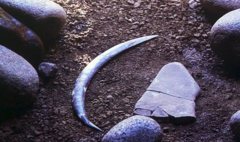A recently reassessed artifact discovered in Poland reveals new insights into ancient human innovation and provides a glimpse into early tools used by Homo sapiens.
Oldest Boomerang Shatters Previous Beliefs About Ancient Craftsmanship

Oldest Boomerang Shatters Previous Beliefs About Ancient Craftsmanship
Archaeologists uncover the world's oldest boomerang, dating back 40,000 years, challenging prior assumptions about prehistoric hunting tools.
The world's oldest boomerang, previously believed to be around 30,000 years old, has been re-dated to approximately 40,000 years. This intriguing artifact, discovered in Oblazowa Cave in southern Poland in 1985, was meticulously carved from mammoth tusk, showcasing the extraordinary craftsmanship of prehistoric peoples.
Recent studies employing advanced radiocarbon dating techniques on nearby animal and human bones have confirmed the tool's impressive age, suggesting it originated between 39,000 and 42,000 years ago. Dr. Sahra Talamo from the University of Bologna emphasized the tool's significance, noting, "It's the oldest boomerang in the world and the only one of this shape and size found in Poland." She highlights the object as a testament to human ingenuity during a time when early Homo sapiens demonstrated remarkable skills and an understanding of aerodynamics suitable for hunting.
Unlike the iconic returning boomerangs commonly associated with Aboriginal Australians, this ancient tool was designed for a one-way flight. Its shape indicates it was used for hunting purposes, but its artistic value cannot be overlooked, hinting at potential use in cultural rituals.
Archaeological findings suggest that boomerangs have appeared across different geographical regions, expanding their historical significance beyond Australia. The oldest known wooden boomerang from Australia dates back 10,500 years, while other fragments have been found in Denmark and the Netherlands.
The groundbreaking research, involving scientists from several European countries, has been published in the journal PLOS One, shedding light on ancient human creativity and the evolutionary path of tool-making. This discovery not only enriches our understanding of prehistoric life but also emphasizes the complex relationship humans have had with their environment for tens of thousands of years.




















